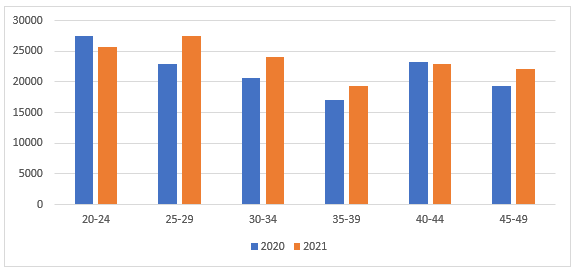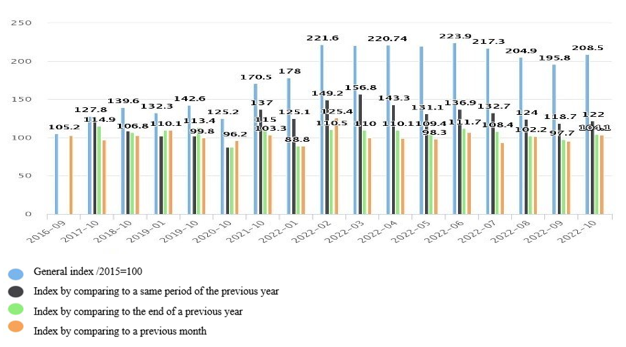Introduction
According to the internationally recognized concept, a project is something that has a beginning, an end, a goal, a scope of work, a budget for implementation, and a unique special outcome. Any project can be of any scale, big or small. The most important is to implement a project very properly. Appropriate management techniques should be used to achieve the final goal. In connection with this, there are many international project standards. The implementation of any project goes through five stages: new idea, plan, performance, control, and the final stage, or the successful completion of the project.
The business world is changing strongly under the influence of new techniques and technologies, and businesses have started to understand the importance of methodological significance for project management methods in the new emerging environment. The importance of project management, defined as the successful conversion of abstract ideas into reality, is increasing more than ever before. There is the lack of qualified project managers in Mongolia with the knowledge, experience, and skills to successfully implement project management in Mongolia, and we believe that the education sector and the private sector will pay attention to the preparation of this type of personnel in the future.
According to the «Project Management Salary Survey» 11th report released by the international organization PMI, 75% of all respondents of this survey pointed out that their salary has increased over the past year. Recent studies have shown that there is a growing demand for project management professionals and their career opportunities regardless of where they belong or rank in the organizational structure. According to PMI, in Germany, where project professionals are the highest paid, the need for project management professionals has grown as the digital transition accelerates.
According to the above-mentioned requirements, Project Management Institute developed and approved ISO 21500 project management standard in Mongolia in May 2013. PMI Mongolia Chapter, the branch of the US-based Project Management Institute (PMI) in Mongolia, has been operating since June 2014 to introduce and expand the best project management practices, methods, and qualifications in Mongolia.
Although our country has decided to introduce a unified standard, the use of the standard is not enough for many projects and programs currently being implemented, and the project management, especially project management standards, is a relatively new concept. Therefore, it is necessary to introduce well to the public and help them to understand its importance. Until now, many foreign and domestic funded projects have been implemented in Mongolia. At this critical time of our country’s development, we have faced the need to learn from international experience, acquire and introduce project management standards, and study regional specific culture, customs and other factors to bring implementation to a world level. Mongolians have the opportunity to participate in giant investment projects. However, we need qualified project professionals.
The population per qualified project leader is 4.5 thousand in China, 3.3 thousand in Japan, 4.5 thousand in South Korea, 1.1 thousand in Hong Kong, 2.1 thousand in Taiwan, while it is 67.8 thousand in Mongolia, which shows how far behind we are from the world in this regard. According to PMI Mongolia Chapter, there is a need for over 3000 people experienced in the project management, obtained PMP certificates and specialized deeply in the projects in our country. But now there are only about 60. Moreover, the number of project-based jobs worldwide is estimated to increase from 90 million in 2019 to 102 million in 2030.
Modern project management standards continue to change rapidly in response to technological and environmental changes.
Table 1
Project standards
| Project standard | International project management association (IPMA)/ (ICB4) | Program & Project Management (P2M) | Project Management Body of Knowledge (PMBOK) | PRINCE2 (Project s IN Controlled Environments) | ISO 21500:2012 Guidance on project management |
| Started using in | 1965 | 2001 | 1987 | 1989 | 2009 |
| Organization in charge | Investment in education development-IED | Project Management Association of Japan (PMAJ) | Project Management Institute (PMI) | Association for Project Management | British Standard Institute |
| Country | EU /Germany/ | Japan | USA | England | Great Britain |
| Number of members | 150,000 | 100,000 | 700,000 | ||
| Member countries | 55 | 40 | 180 countries 260 branches | 50 | 170 countries 31 branches |
| Features | Based on qualification | Based on innovation | Basic concept of knowledge | Based on control | Based on quality |
Source: (Otsuki, 2013)
Research on construction projects
Construction, infrastructure and engineering network works include all construction works such as railways, roads, bridges, highways, airport sites, power generation, water supply, wastewater networks, dams, and irrigation facilities. Fixed assets are tangible and intangible assets that are produced in the form of outputs as a result of production activities and are repeatedly used for one or more years in other production activities.
Mongolia produces 37% of construction materials domestically and imports 63% from abroad. But in the last 2 years, the price of construction materials has increased by 45%. Due to the many issues caused by the COVID-19 pandemic, there has been a fluctuation in the period of operation of most of the apartments, as a result, the demand for apartments with average square meters has increased, and the demand for apartments with large square meters has decreased.
As of July 2021, an average price of new apartments receiving orders in Ulaanbaatar City reached 2.73 million MNT increasing by 0.73% than a previous month and by 10.85% than a previous year. As of July 2021, the average price in Sukhbaatar District reached 4.06 million MNT by increasing by 1.71% of a previous month and by 41.26% than previous year.
Table 2
Average price of new apartment /in districts/
| Districts | July, 2020 | June, 2021 | July, 2021 |
| Bayangol | 2.147.157 | 2.598.690 | 2.413.704 |
| Bayanzurkh | 2.251.281 | 2.452.830 | 2.454.412 |
| SonginoKhairkhan | 1.747.500 | 2.063.529 | 2.028.125 |
| Sukhbaatar | 2.872.477 | 3.989.405 | 4.057.723 |
| Khan-Uul | 3.061.913 | 3.442.226 | 3.498.332 |
| Chingeltei | 3.775.000 | 3.320.000 | 3.320.000 |
| Remote area | 1.410.000 | 1.333.333 | 1.366.667 |
| District average | 2.466.477 | 2.714.288 | 2.734.137 |
In terms of production, Mongolia imports most of the products due to the fact that Mongolia cannot carry out sustainable activities depending on technology, geographical location, natural climate, and human resources.

Figure 1. Incomplete use of labor, by age
There is a change in the price of construction because of the decrease in labor productivity.

Figure 2. Price index
According to above tables,
- Productivity of human resources and time management is decreasing.
- Production of materials and composition of price costs increase depending on external and internal factors.
- Costs of import and transport logistics are increasing due to the increase in the price of fuel, customs, and the poor organization.
Conclusion
Construction and infrastructure projects in Mongolia are weak in terms of management systems such as planning, organization, performance and control, and socio-economic, educational and political structure such as difficult regional and climatic conditions, lack of production technical equipment, lack of stable human resources policy, and lack of coordination of relations between stakeholders related to projects. Therefore, there is a need to correct the productivity and the unsuccessful implementation of projects. By improving the educational system, empowering human resources, building and operating strategic heavy and light industries, improving diplomatic relations with neighboring countries, and speeding up the circulation of border customs and transportation logistics, coordinating the relations of the stakeholders, the public and private sectors, reducing corruption in a sequential manner will make a valuable contribution to the development of Mongolia.
References
1. Otsuki, N. (2013). Comparison of international project management standards, Japan Project Management Association.2. https://1212.mn/
3. Georgina Palffy (2015) How to do a business? /www.dk.com/
4. Peter Drucker (2007) Professional Management.
